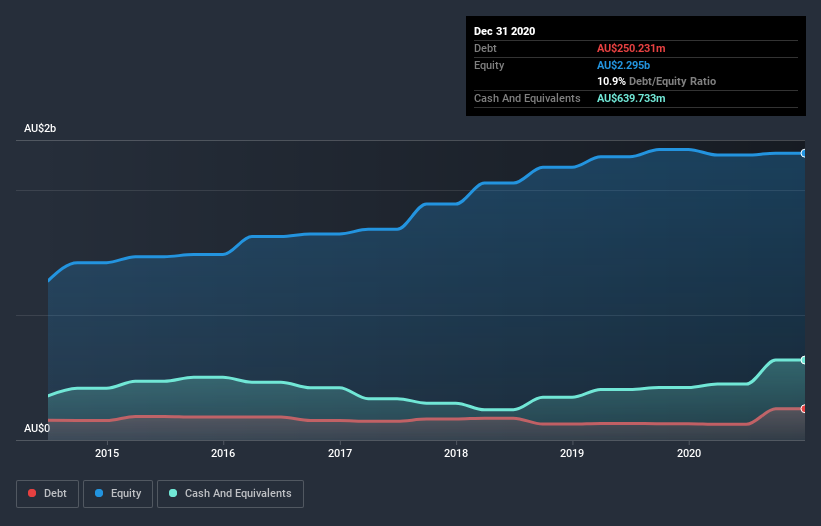- Australia
- /
- Real Estate
- /
- ASX:UOS
These 4 Measures Indicate That United Overseas Australia (ASX:UOS) Is Using Debt Reasonably Well

Warren Buffett famously said, 'Volatility is far from synonymous with risk.' So it might be obvious that you need to consider debt, when you think about how risky any given stock is, because too much debt can sink a company. We can see that United Overseas Australia Limited (ASX:UOS) does use debt in its business. But is this debt a concern to shareholders?
When Is Debt Dangerous?
Debt and other liabilities become risky for a business when it cannot easily fulfill those obligations, either with free cash flow or by raising capital at an attractive price. If things get really bad, the lenders can take control of the business. While that is not too common, we often do see indebted companies permanently diluting shareholders because lenders force them to raise capital at a distressed price. Of course, the upside of debt is that it often represents cheap capital, especially when it replaces dilution in a company with the ability to reinvest at high rates of return. When we examine debt levels, we first consider both cash and debt levels, together.
See our latest analysis for United Overseas Australia
How Much Debt Does United Overseas Australia Carry?
The image below, which you can click on for greater detail, shows that at December 2020 United Overseas Australia had debt of AU$250.2m, up from AU$130.2m in one year. However, its balance sheet shows it holds AU$639.7m in cash, so it actually has AU$389.5m net cash.

How Healthy Is United Overseas Australia's Balance Sheet?
We can see from the most recent balance sheet that United Overseas Australia had liabilities of AU$417.3m falling due within a year, and liabilities of AU$48.0m due beyond that. On the other hand, it had cash of AU$639.7m and AU$175.8m worth of receivables due within a year. So it actually has AU$350.3m more liquid assets than total liabilities.
This excess liquidity is a great indication that United Overseas Australia's balance sheet is almost as strong as Fort Knox. Having regard to this fact, we think its balance sheet is as strong as an ox. Simply put, the fact that United Overseas Australia has more cash than debt is arguably a good indication that it can manage its debt safely.
In fact United Overseas Australia's saving grace is its low debt levels, because its EBIT has tanked 22% in the last twelve months. Falling earnings (if the trend continues) could eventually make even modest debt quite risky. The balance sheet is clearly the area to focus on when you are analysing debt. But you can't view debt in total isolation; since United Overseas Australia will need earnings to service that debt. So if you're keen to discover more about its earnings, it might be worth checking out this graph of its long term earnings trend.
Finally, a company can only pay off debt with cold hard cash, not accounting profits. While United Overseas Australia has net cash on its balance sheet, it's still worth taking a look at its ability to convert earnings before interest and tax (EBIT) to free cash flow, to help us understand how quickly it is building (or eroding) that cash balance. Over the last three years, United Overseas Australia recorded free cash flow worth a fulsome 92% of its EBIT, which is stronger than we'd usually expect. That puts it in a very strong position to pay down debt.
Summing up
While we empathize with investors who find debt concerning, you should keep in mind that United Overseas Australia has net cash of AU$389.5m, as well as more liquid assets than liabilities. The cherry on top was that in converted 92% of that EBIT to free cash flow, bringing in AU$153m. So we don't think United Overseas Australia's use of debt is risky. When analysing debt levels, the balance sheet is the obvious place to start. However, not all investment risk resides within the balance sheet - far from it. These risks can be hard to spot. Every company has them, and we've spotted 3 warning signs for United Overseas Australia (of which 1 is concerning!) you should know about.
At the end of the day, it's often better to focus on companies that are free from net debt. You can access our special list of such companies (all with a track record of profit growth). It's free.
If you decide to trade United Overseas Australia, use the lowest-cost* platform that is rated #1 Overall by Barron’s, Interactive Brokers. Trade stocks, options, futures, forex, bonds and funds on 135 markets, all from a single integrated account. Promoted
New: AI Stock Screener & Alerts
Our new AI Stock Screener scans the market every day to uncover opportunities.
• Dividend Powerhouses (3%+ Yield)
• Undervalued Small Caps with Insider Buying
• High growth Tech and AI Companies
Or build your own from over 50 metrics.
This article by Simply Wall St is general in nature. It does not constitute a recommendation to buy or sell any stock, and does not take account of your objectives, or your financial situation. We aim to bring you long-term focused analysis driven by fundamental data. Note that our analysis may not factor in the latest price-sensitive company announcements or qualitative material. Simply Wall St has no position in any stocks mentioned.
*Interactive Brokers Rated Lowest Cost Broker by StockBrokers.com Annual Online Review 2020
Have feedback on this article? Concerned about the content? Get in touch with us directly. Alternatively, email editorial-team (at) simplywallst.com.
About ASX:UOS
United Overseas Australia
Engages in the development and resale of land and buildings in Malaysia, Singapore, Vietnam, and Australia.
Excellent balance sheet and fair value.

